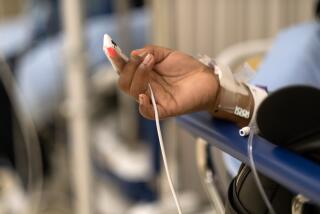Scripps Reports Groundbreaking Septic Shock Study
- Share via
Life-threatening shock after bacterial infections occurs because a natural protein in the blood helps bacterial toxins bind to a specific site on the wall of infection-fighting cells, researchers in San Diego and New York have found.
The findings suggest earlier ways in which doctors might eventually be able to block the cascade of chemical reactions that lead to septic shock.
“We hope that whatever basic research we’ve done will provide new opportunities for therapy in a disease where effective therapy has not been available,” said Richard J. Ulevitch, a biochemist at the Research Institute of Scripps Clinic. “The type of work that’s required to take this research to a therapeutic stage is pretty clear now.”
Ulevitch was the chief author on one of two papers delineating the findings, which are published in today’s edition of the journal Science. The lead author on the companion paper was Samuel Wright, a cell biologist at Rockefeller University in New York City.
Others involved in the work at Scripps were John Mathison, Peter Tobias and Dr. Ralph Schumann. Collaborators elsewhere included R.A. Ramos at Rockefeller; and S.R. Leong, G.W. Flaggs and P.W. Gray at Genentech Inc. in San Francisco.
Septic shock occurs in 50,000 to 100,000 Americans every year, said Dr. John Harlan, chief of hematology at the University of Washington Medical School.
It can occur after a primary bacterial infection or a secondary infection acquired after a patient has been hospitalized for cancer, AIDS, trauma or surgery. Characterized by plummeting blood pressure and organ failure, septic shock almost invariably leads to death once it reaches the advanced stages, Harlan said.
“It’s a big problem,” Harlan said. “So any intervention that would reduce mortality is welcome.”
Molecular-level studies over the last few years have shown that, in infection with certain kinds of common bacteria, septic shock occurs because of endotoxins, fat-sugar molecules from the bacteria’s cell wall, Ulevitch explained. This leads to an overabundance of a natural inflammatory chemical, tumor necrosis factor (TNF). A little bit of TNF at an infection site helps the body fight off the infection; too much produces septic shock.
But it was not until the Scripps/Rockefeller research published today that two key events preceding the release of TNF were known:
* For the endotoxin to do its damage, it must first be bound chemically to a natural protein in the blood, which the researchers named lipopolysaccharide binding protein.
* After they bind together, the combination molecule attaches to the outside of infection-fighting monocyte cells via a protein structure known as CD14.
The function of this CD14 “receptor” protein had not been known before now.
It is groundbreaking work to find out what such receptors do in the body, noted Ian Trowbridge, an immunologist at the Salk Institute in San Diego.
“A lot of these (receptor) molecules were characterized on the basis of structure and were thought to be important, but the real key over the last couple of years has been to try to find out what these molecules do,” Trowbridge said. “And this is another example of something that’s clearly of tremendous functional importance.”
Currently, there are clinical trials of drugs that would block TNF released by the body in response to bacterial endotoxins, Harlan noted. However, it would be better to block the process at a point before TNF is produced at all, he said.
The Scripps/Rockefeller work provides a preliminary target for a mechanism to do this, by using proteins called monoclonal antibodies to block either the lipopolysaccharide binding protein or the CD14 receptor itself.
Finding effective ways to deal with septic shock is increasing in importance because of a marked increase over the last decade in septicemia, accumulation of bacteria in the blood that can lead to septic shock.
In 1979, fewer than 10% of infectious disease patients released from hospitals in the United States had a septicemia diagnosis. By 1987, that had risen to 25%, according the U.S. Centers for Disease Control.
Ulevitch said his current work is being watched closely by Johnson & Johnson Co., which has an option on marketing rights to certain research developed at Scripps. But much of the basic science leading up to the current work was done under National Institutes of Health grants going as far back as 1974.
His research group first described the lipopolysaccharide binding protein in 1986, although its function was not then known, he said.





